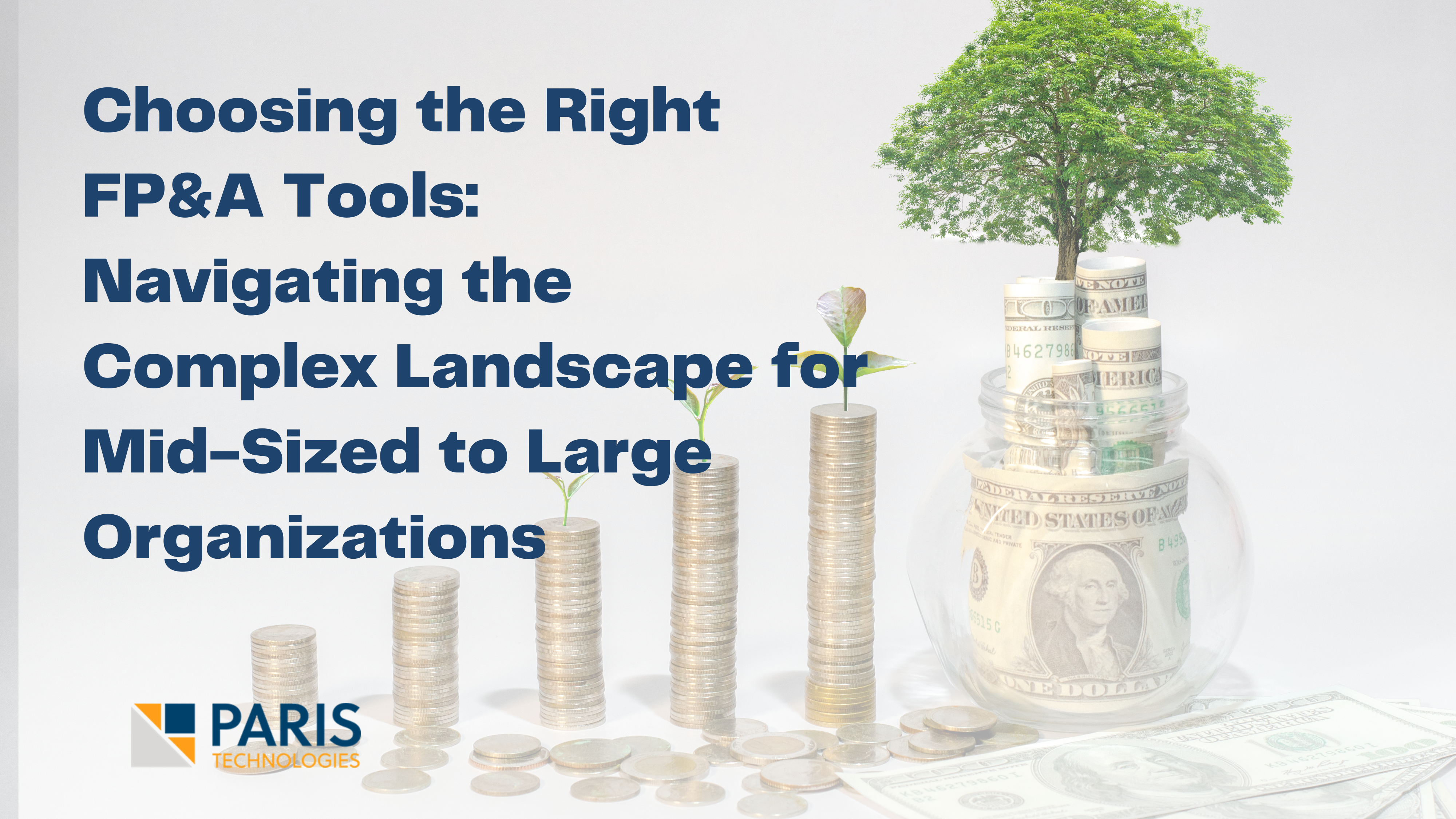No longer reduced to a back-office function, today’s financial planning and analysis (FP&A) processes consistently evolve into a strategic cornerstone for organizational success.
As businesses expand, managing internal finances becomes increasingly complex, and finding the right FP&A tools is essential. This guide breaks down the options, helping organizations find – and know how to implement – the best fit for their needs.

What is FP&A and Why Does It Matter?
Financial Planning and analysis (FP&A) is an all-encompassing concept that includes various processes of gathering, analyzing, and evaluating financial information to support business decisions and drive company progress. All key facets of guiding strategic planning – budgeting, forecasting, economic modeling, and performance analysis – are crucial to establishing mid-sized to large organizations.
Yet, despite the necessity of robust FP&A processes for growing organizations, businesses often struggle to harness their data. A lack of a strong structural foundation in the process can create struggles with data silos, perpetuate time-consuming manual processes, and difficulty in balancing short-term management with long-term planning.
Types of FP&A Solutions Available
Enterprise FP&A Software
Enterprise FP&A solutions are comprehensive platforms for larger organizations with complex financial structures. Enterprise FP&A software offers advanced capabilities beyond basic budgeting, including multidimensional modeling, enterprise-wide data integration, workflow management, and sophisticated reporting.
Notable enterprise FP&A software includes PARIS Technologies, Anaplan, Oracle EPM Cloud, and SAP Analytics Cloud. These platforms provide the scalability needed for growing businesses, although they typically require significant implementation resources.
Excel-Based FP&A Solutions
Despite the proliferation of specialized FP&A tools, Microsoft Excel is the most widely used across organizations and various seniority levels. Excel offers familiarity across finance teams and flexibility for customized calculations with low initial investment. That said, it presents limitations in collaboration capabilities, version control issues, scaling challenges for complex organizations, and vulnerability to errors.
Excel-based solutions work for smaller organizations with straightforward planning needs. However, as companies grow beyond 100 employees or develop complex business models, spreadsheet limitations often necessitate more sophisticated financial planning and analysis solutions – where collaborative, Excel-based planning and analytics solutions can be helpful.
Cloud-Based FP&A Software
Cloud-based FP&A software has gained significant traction by offering real-time collaboration, automatic updates, lower IT requirements, and mobile accessibility.
Organizations should carefully consider their unique data security provisions, integration capabilities with existing systems, customization options, and vendor stability when evaluating these options to find one that works best specifically for them. The right FP&A solution will balance these factors against specific organizational needs.
Budgeting & Forecasting Tools: What to Look For
Planning, budgeting, and forecasting (PBF) software is at the core of FP&A functionality, as these tools streamline critical financial processes. Their most essential features can include:
- Automation capabilities
- Driver-based modeling
- Rolling forecasts
- Scenario modeling
- Collaborative workflows and version control
Top budgeting and forecasting tools include Prophix (decisive in consolidation), Board (integrates planning with business intelligence), Jedox (offers flexible modeling), and Solver (designed for mid-market ERP environments). Each represents a different approach to financial planning and analysis software.
The Role of Scenario Planning in FP&A
Scenario planning has become vital for navigating uncertain times and volatile markets. This approach involves creating multiple future scenarios based on different assumptions, which can help organizations prepare for various potential outcomes.
Scenario planning differs from essential forecasting by considering a broader range of possibilities, incorporating financial and non-financial variables, and developing contingency plans. The best FP&A solutions provide flexible assumption management, side-by-side scenario comparison, and visualization of scenario impacts.
Choosing the Best FP&A Software for Your Organization
Selecting the right enterprise FP&A tools requires careful consideration of scalability (will the solution grow with your organization?), integrations (does it connect with your accounting system?), automation (what manual processes can be eliminated?), and cost considerations beyond subscription fees.
Enterprise organizations typically require multi-entity consolidation, complex allocation methodologies, and robust governance features. Mid-sized businesses often prioritize faster implementation, lower total cost, and ease of use with limited specialized staff.
Future Trends in FP&A Solutions
The FP&A landscape continues to evolve with AI-powered forecasting, improving accuracy by identifying historical data patterns. The shift toward cloud-based enterprise FP&A is accelerating, driven by remote work requirements and the need for greater flexibility.
Modern financial planning and analysis software increasingly emphasizes visual storytelling, transforming complex financial data into intuitive dashboards. Extended Planning & Analysis (xP&A) also connects FP&A with workforce, sales, and operational planning for a more holistic view of business performance.
FAQs on FP&A Solutions
What is FP&A Software?
Financial planning and analysis (FP&A) software provides budgeting, forecasting, reporting, and analysis tools, helping organizations plan their financial future and track performance against those plans. Modern FP&A solutions automate manual processes while providing deeper insights through advanced analytics.
What are the best FP&A solutions for mid-sized businesses?
Mid-sized businesses often succeed with platforms like Workday Adaptive Planning, Planful, and Prophix, which offer robust functionality without the complexity and cost of enterprise-grade solutions. The ideal choice depends on specific industry requirements and existing technology infrastructure.
How does cloud-based FP&A compare to traditional tools?
Cloud-based FP&A solutions offer advantages in accessibility, collaboration, and maintenance compared to on-premises alternatives. They typically provide more frequent updates, reduced IT overhead, and greater flexibility for distributed teams.
What-if scenario analysis vs. scenario planning—what’s the difference?
What-if scenario analysis typically changes specific variables to observe immediate financial impacts. Scenario planning takes a broader approach, creating comprehensive alternative futures based on different environmental assumptions. Both methods complement each other within a robust FP&A framework.
Why Modern FP&A Solutions are Important
Selecting the right FP&A solution is a strategic investment in efficiency, accuracy, and long-term financial stability. Organizations can move beyond the limitations of disconnected spreadsheets and manual processes by choosing a platform that aligns with existing workflows and business needs. PARIS Tech offers a flexible approach, allowing teams to maintain their preferred tools while enhancing collaboration, automation, and data integrity. As financial complexity grows, solutions that streamline planning and reporting will be increasingly critical in helping businesses adapt and succeed. Book a call with us today!


